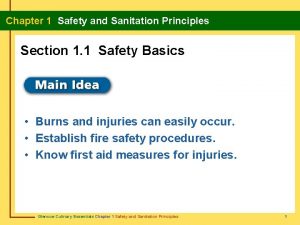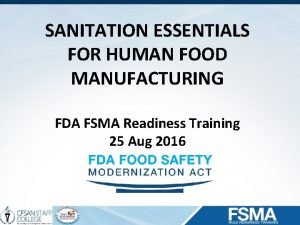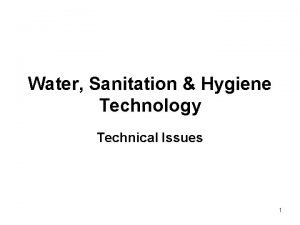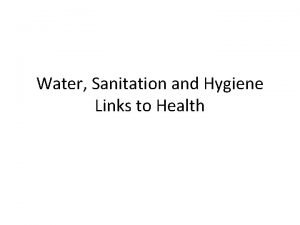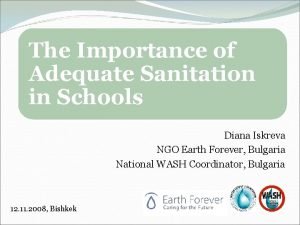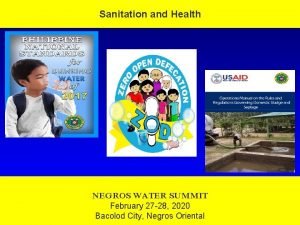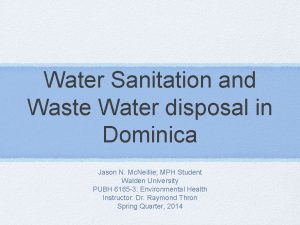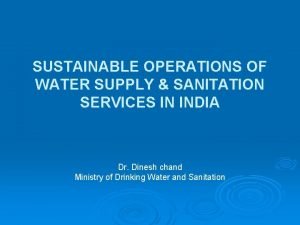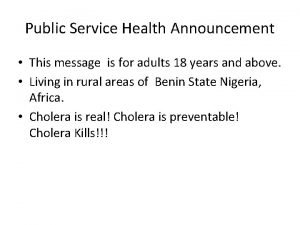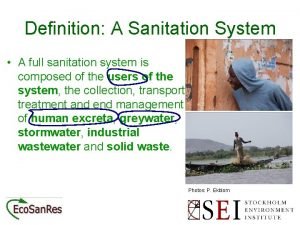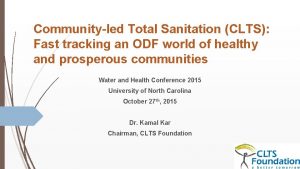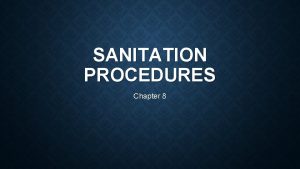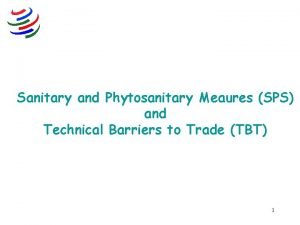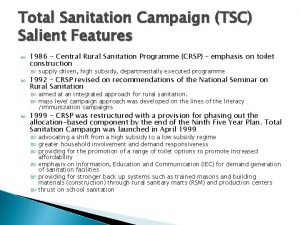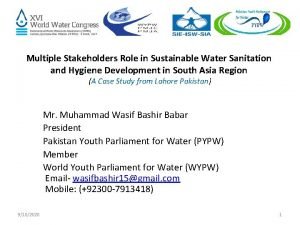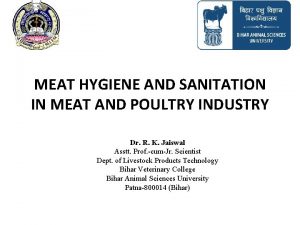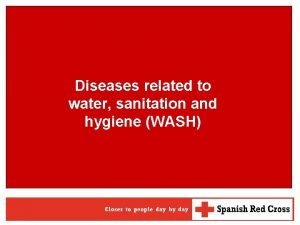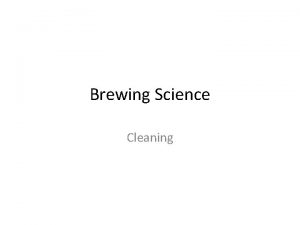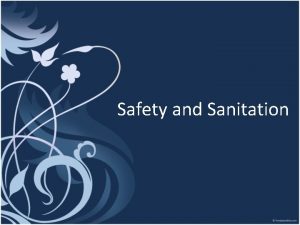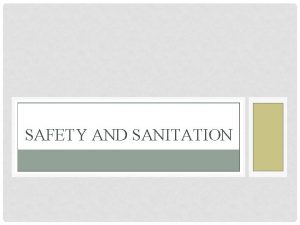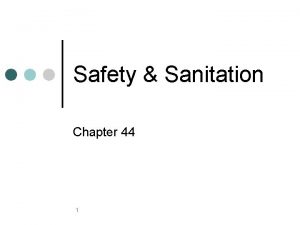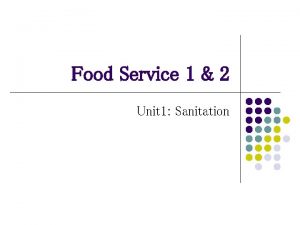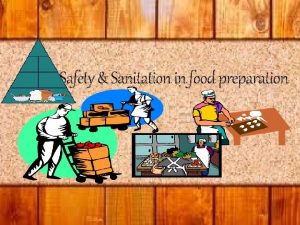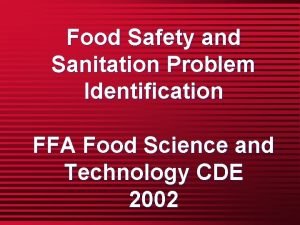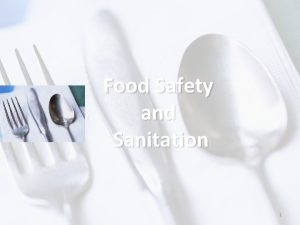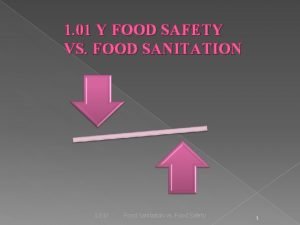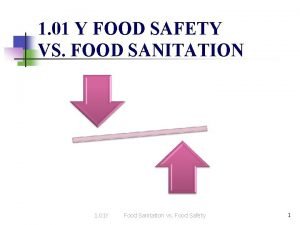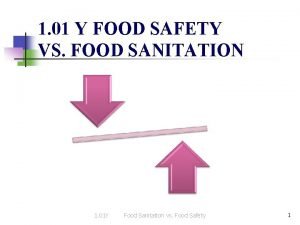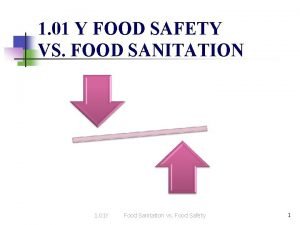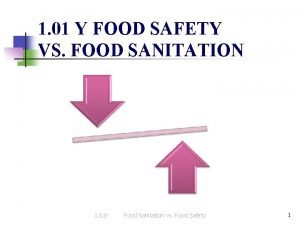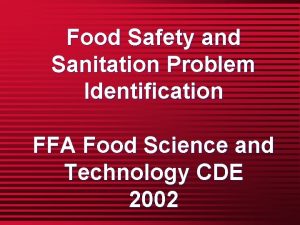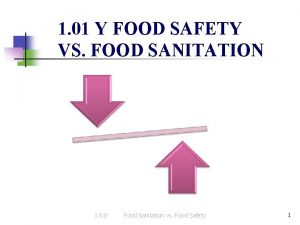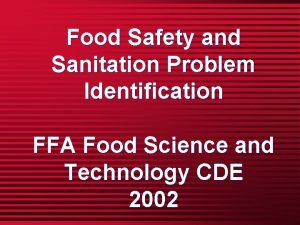1 01 Y FOOD SAFETY VS FOOD SANITATION






















- Slides: 22

1. 01 Y FOOD SAFETY VS. FOOD SANITATION 1. 01 Y Food Sanitation vs. Food Safety 1

What’s the difference? Food safety is how food is handled to prevent foodborne illness. Food sanitation is the cleanliness of equipment and facilities. 1. 01 Y Food Sanitation vs. Food Safety 2

Food Safety Food safety is how food is handled to prevent foodborne illness. This includes: § Food preparation methods § Cooking § Chilling § Serving 1. 01 Y Food Sanitation vs. Food Safety 3

Food Preparation Methods § Raw foods must be kept separate from ready to eat foods to PREVENT cross contamination. § Food must be kept out of the temperature danger zone 40°-140° for personal/home 41°-135° for food service and use to PREVENT foodborne illness. 1. 01 Y Food Sanitation vs. Food Safety 4

Cooking Food § Meats should be cooked to the proper internal temperature to prevent foodborne illness. § The temperatures for cooking ground beef and chicken are: o Ground Beef 160 home / 155° for food service o Chicken 170 home / 165° for food service 1. 01 Y Food Sanitation vs. Food Safety 5

Serving Food § Food should be served as quickly as possible after preparation and held at 135° for food service 140° personal/home use § Food should be kept cold if serving from a food bar and held at 40° for personal/home use and 41°for food service. 1. 01 Y Food Sanitation vs. Food Safety 6

Chilling Food o § Foods must chilled to below 40 home/personal use and 41° for food service to prevent foodborne illness. § Foods should be cooled in small containers to help speed the cooling process. § Foods that are chilling should be covered to prevent cross contamination. 1. 01 Y Food Sanitation vs. Food Safety 7

Food Sanitation Food sanitation is the cleanliness and maintenance of equipment and facilities. It is important for the safety of lab members and the preparation of food. 1. 01 Y Food Sanitation vs. Food Safety 8

Food Sanitation cont. The areas of food sanitation include: § hands § pots and pans § appliances § kitchen utensils § food preparation areas § food storage areas 1. 01 Y Food Sanitation vs. Food Safety 9

Pots and Pans For the safety of lab members and proper food preparation pots and pans : § must be clean § have secure handles § should have flat bottoms § lids must have handles § made from food grade metal 1. 01 Y Food Sanitation vs. Food Safety 10

Appliances • Appliances that are not working properly are a danger to anyone who is operating them. • Appliances that have cracks and crevices can harbor bacteria that can cause a foodborne illness. 1. 01 Y Food Sanitation vs. Food Safety 11

Appliances cont. • It is important that appliances: § be smooth and easy to clean § attachments should be used properly 1. 01 Y Food Sanitation vs. Food Safety 12

Kitchen and Serving Utensils • Both kitchen and serving utensils must be: § easy to clean § made from food grade metal § nonporous 1. 01 Y Food Sanitation vs. Food Safety 13

Food Preparation Areas Food preparation areas have the potential for cross contamination of food. To PREVENT this food preparation areas: § must be easy to clean § must be non-porous § be free from cracks and crevices 1. 01 Y Food Sanitation vs. Food Safety 14

Food Storage Areas § Food storage areas protect food from cross contamination from bacteria and other hazards. § Food storage areas must be: • kept clean • able to be covered • away from the wall and off of the floor 1. 01 Y Food Sanitation vs. Food Safety 15

1. 01 T Food Sanitation 1. 01 T Food Sanitation

Hand Sanitation 1. Wet hands with WARM water. 2. Soap and scrub for 10 -15 seconds. 3. Rinse under clean, running water. 4. Dry completely using a clean cloth or paper towel. 1. 01 T Food Sanitation 17

Kitchen Equipment Kitchen equipment should be: • Clean • Properly working 1. 01 T Food Sanitation 18

Cleaning • Dishes should be washed in hot soapy water, rinsed and air dried. • Dish cloths and sponges should be changed regularly. 1. 01 T Food Sanitation 19

Sanitizing • Equipment can be sanitized with one teaspoon of bleach in a gallon of water. Surfaces should be sanitized regularly. • Sanitation is to clean equipment in a way that kills germs and parasites. 1. 01 T Food Sanitation 20

Pests • Pests lead to the spread of germs and bacteria to food surfaces, equipment and food. • Pest infestation lead to the loss of food in labs. 1. 01 T Food Sanitation 21

Pest Control Pests can be controled by: • Cleaning up leftover foods. • Removing garbage regularly. • Keeping doors closed and windows shut. 1. 01 T Food Sanitation 22
 Chapter 1 safety and sanitation principles
Chapter 1 safety and sanitation principles Ssop checklist
Ssop checklist Sanitation and hygiene
Sanitation and hygiene Sanitation and hygiene
Sanitation and hygiene Concept school
Concept school Delvic sanitation initiatives
Delvic sanitation initiatives Environmental sanitation clearance
Environmental sanitation clearance Sanitation importance
Sanitation importance National shellfish sanitation program
National shellfish sanitation program Moeller sanitation
Moeller sanitation Conclusion on sanitation
Conclusion on sanitation Hygiene conclusion
Hygiene conclusion Pdq sanitation
Pdq sanitation Sanitation system definition
Sanitation system definition Odf tracking
Odf tracking Chapter 8 sanitation procedures
Chapter 8 sanitation procedures Sps barriers
Sps barriers Central rural sanitation programme 1986
Central rural sanitation programme 1986 Drawing of sanitation
Drawing of sanitation Stakeholders in water and sanitation
Stakeholders in water and sanitation Poultry hygiene and sanitation
Poultry hygiene and sanitation Sanitation and hygiene
Sanitation and hygiene Cleaning and sanitation manual for breweries
Cleaning and sanitation manual for breweries
